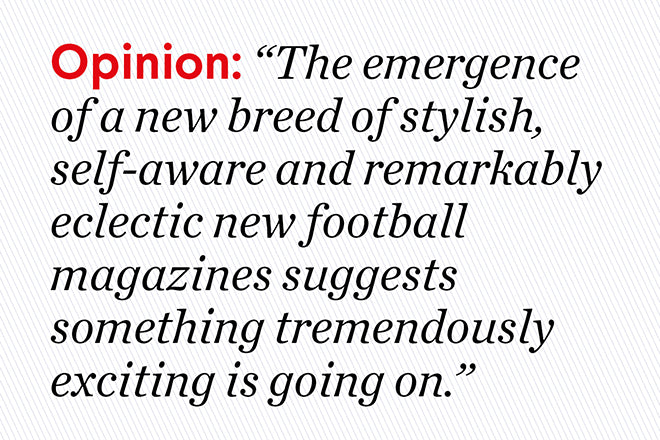
The fall and rise of the football magazine
As Euro2016 reaches the semi-final stage our columnist notes a new golden generation of football magazines
I have enjoyed the Euros this summer, but as with any major football tournament it has been a bit weird too. We’ve had the emergence of “plucky little Wales” as a thrilling and ruthlessly efficient footballing joy. There has been the increase in fans adopting the opening chords of Seven Nation Army as a sort of pan-European national anthem (suck on that Farage). And there has been the bizarre pitchside adverts for “Energy of Azerbaijan" displayed during every game, presumably so that next time you pop out to pick up a six-pack of energy, you find yourself drawn to the only brand savvy enough to align itself with Poland v Switzerland.
The biannual rolling around of the World Cup or the Euros is a good time to take stock of the state of the game and its place in our wider cultural affairs. And in recent years the emergence of a new breed of stylish, self-aware and remarkably eclectic new football magazines suggests something tremendously exciting is going on.
I can’t profess objectivity here – the first magazine I ever loved was Match. As a kid, every Tuesday morning I would drop into our local Circle K to collect the new issue (which, as a rather pompous 11-year-old, I insisted they “put aside” for me). It was printed on cheap shiny paper but I didn’t care because it had a slightly irreverent edge that I loved (and still love) in any printed publication. Not everybody loved Match; there were those (idiots) who preferred Match’s mortal rival, Shoot. Which title you sided with said a lot about you, kind of like the Bloods and the Crips played out in suburban Sutton Coldfield.
After outgrowing my first magazine crush, it was exciting to discover there was a tranche of grown-up football titles on which I could spend my pocket money; magazines like FourFourTwo, which survives, and Total Football and 90 Minutes, which don’t. This was the height of 1990s laddism, but I remember these magazines as being much more engaging than the boobs-beer-bantz culture espoused elsewhere. Unlike the mainstream media, they treated football fans not as Carling-deranged hooligans, but multi-faceted readers with intelligence, knowledge and a sense of humour (although I did once write to the editor of FourFourTwo to complain about a disparaging reference to Sutton Coldfield in the standfirst of an interview with Aston Villa defender Ugo Ehiogu. Some allegiances die hard).
As with music, fanzine culture was in rude health too. When Saturday Comes continues to maintain the spirit of those one-club publications on a broader scale.
And then, of course, the internet happened. Many fanzines folded as supporters flocked online, and forums flourished, empowering and exasperating in equal measure. As in every other sector, print products suddenly had to justify their existence, and in the final spreadsheet reckoning, many simply couldn’t do so. 90 Minutes closed in 1997, Goal in 1998, Total Football and the BBC’s Match of the Day magazine both shut in 2001. A new title called Eleven launched in September 2002; it lasted less than a year.
But in this familiar story, while some mags struggled, others made it work. FourFourTwo and When Saturday Comes both survived and thrived, tailoring their approaches to the new digitally-defined cultural landscape. The internet also opened up new opportunities, identifying groups of fans with a hunger for nerdy, in-depth, often tactically complex football writing. The Swedish bi-monthly Offside led the way in 2000, running features up to 30 pages long. That inspired titles like The Blizzard, which its founder conceived as a home for “detailed reportage, history and analysis.”
As independent publishing rallied, it is not surprising that new football titles became part of this movement. These magazines very often followed the same formula which had served the new breed of indie mags so well, with high production values, clean design and eclectic subject matter explored through the prism of a central theme, in this case football.
The Green Soccer Journal was one of the frontrunners – it was witty and stylish and, at its best, thrillingly unexpected. Sadly it ceased printing after its eighth issue (for which, and I hope this is a coincidence, I wrote an article). But it set a template that endures.
Japanese magazine Shukyu followed in its footsteps, and hit on that same killer combination of great content and great design. Reviewing its recent second issue on this site, Jeremy wrote that it “will appeal to the football fan for its unique outlook on the sport and to the magaholic for the perfection of its format and physical presence.” Its features ranged from an illustrated guide to managers’ body language tics, to a look at the Japanese national team’s training base in Fukushima. In the UK, Mundial magazine emerged, bringing together football, fashion and a tone of voice which resonates perfectly with fans who love football but hate some of the things that go with it.
Now we are seeing new titles which bringing more specific viewpoints to football publishing. The much-lauded Season focuses on female supporters. “We are often overlooked or sexualised in the football landscape so I wanted to document and celebrate female fandom creatively,” editor Felicia Pennant told magCulture. Meanwhile Scottish football title Nutmeg raised 50% more than its Kickstarter target and it will be interesting to see its first issue due out later this year.
This variety can only be good for those of us who find ourselves in the Venn diagram overlap of football fans and print lovers. Inspired by, but slightly competing with each other too, we can expect these titles to grow in confidence. And if it wasn’t a phrase utterly tarnished by the Gerrard-Lampard axis of underachievement, I’d say this could become a golden generation of football titles.
Rob Alderson is managing editor of WeTransfer and a freelance arts and design writer.









